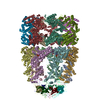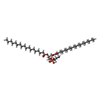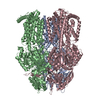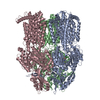+Search query
-Structure paper
| Title | Bacterial efflux pump modulators prevent bacterial growth in macrophages and under broth conditions that mimic the host environment. |
|---|---|
| Journal, issue, pages | mBio, Vol. 14, Issue 6, Page e0249223, Year 2023 |
| Publish date | Nov 3, 2023 |
 Authors Authors | Samual C Allgood / Chih-Chia Su / Amy L Crooks / Christian T Meyer / Bojun Zhou / Meredith D Betterton / Michael R Barbachyn / Edward W Yu / Corrella S Detweiler /  |
| PubMed Abstract | New approaches for combating microbial infections are needed. One strategy for disrupting pathogenesis involves developing compounds that interfere with bacterial virulence. A critical molecular ...New approaches for combating microbial infections are needed. One strategy for disrupting pathogenesis involves developing compounds that interfere with bacterial virulence. A critical molecular determinant of virulence for Gram-negative bacteria are efflux pumps of the resistance-nodulation-division family, which includes AcrAB-TolC. We previously identified small molecules that bind AcrB, inhibit AcrAB-TolC, and do not appear to damage membranes. These efflux pump modulators (EPMs) were discovered in an in-cell screening platform called SAFIRE (Screen for Anti-infectives using Fluorescence microscopy of IntracellulaR Enterobacteriaceae). SAFIRE identifies compounds that disrupt the growth of a Gram-negative human pathogen, serotype Typhimurium (. Typhimurium), in macrophages. We used medicinal chemistry to iteratively design ~200 EPM35 analogs and test them for activity in SAFIRE, generating compounds with nanomolar potency. Analogs were demonstrated to bind AcrB in a substrate binding pocket by cryo-electron microscopy. Despite having amphipathic structures, the EPM analogs do not disrupt membrane voltage, as monitored by FtsZ localization to the cell septum. The EPM analogs had little effect on bacterial growth in standard Mueller Hinton Broth. However, under broth conditions that mimic the micro-environment of the macrophage phagosome, is required for growth, the EPM analogs are bacteriostatic, and the EPM analogs increase the potency of antibiotics. These data suggest that under macrophage-like conditions, the EPM analogs prevent the export of a toxic bacterial metabolite(s) through AcrAB-TolC. Thus, compounds that bind AcrB could disrupt infection by specifically interfering with the export of bacterial toxic metabolites, host defense factors, and/or antibiotics.IMPORTANCEBacterial efflux pumps are critical for resistance to antibiotics and for virulence. We previously identified small molecules that inhibit efflux pumps (efflux pump modulators, EPMs) and prevent pathogen replication in host cells. Here, we used medicinal chemistry to increase the activity of the EPMs against pathogens in cells into the nanomolar range. We show by cryo-electron microscopy that these EPMs bind an efflux pump subunit. In broth culture, the EPMs increase the potency (activity), but not the efficacy (maximum effect), of antibiotics. We also found that bacterial exposure to the EPMs appear to enable the accumulation of a toxic metabolite that would otherwise be exported by efflux pumps. Thus, inhibitors of bacterial efflux pumps could interfere with infection not only by potentiating antibiotics, but also by allowing toxic waste products to accumulate within bacteria, providing an explanation for why efflux pumps are needed for virulence in the absence of antibiotics. |
 External links External links |  mBio / mBio /  PubMed:37921493 / PubMed:37921493 /  PubMed Central PubMed Central |
| Methods | EM (single particle) |
| Resolution | 2.44 - 2.71 Å |
| Structure data | EMDB-44496, PDB-9bfh: EMDB-44500, PDB-9bfm: EMDB-44501, PDB-9bfn: EMDB-44506, PDB-9bft: |
| Chemicals |  PDB-1an8:  ChemComp-HOH:  PDB-1aon:  ChemComp-3PE:  PDB-1aoe:  PDB-1aof: |
| Source |
|
 Keywords Keywords |  TRANSLOCASE / AcrB Multidrug Efflux Pump TRANSLOCASE / AcrB Multidrug Efflux Pump |
 Movie
Movie Controller
Controller Structure viewers
Structure viewers About Yorodumi Papers
About Yorodumi Papers













